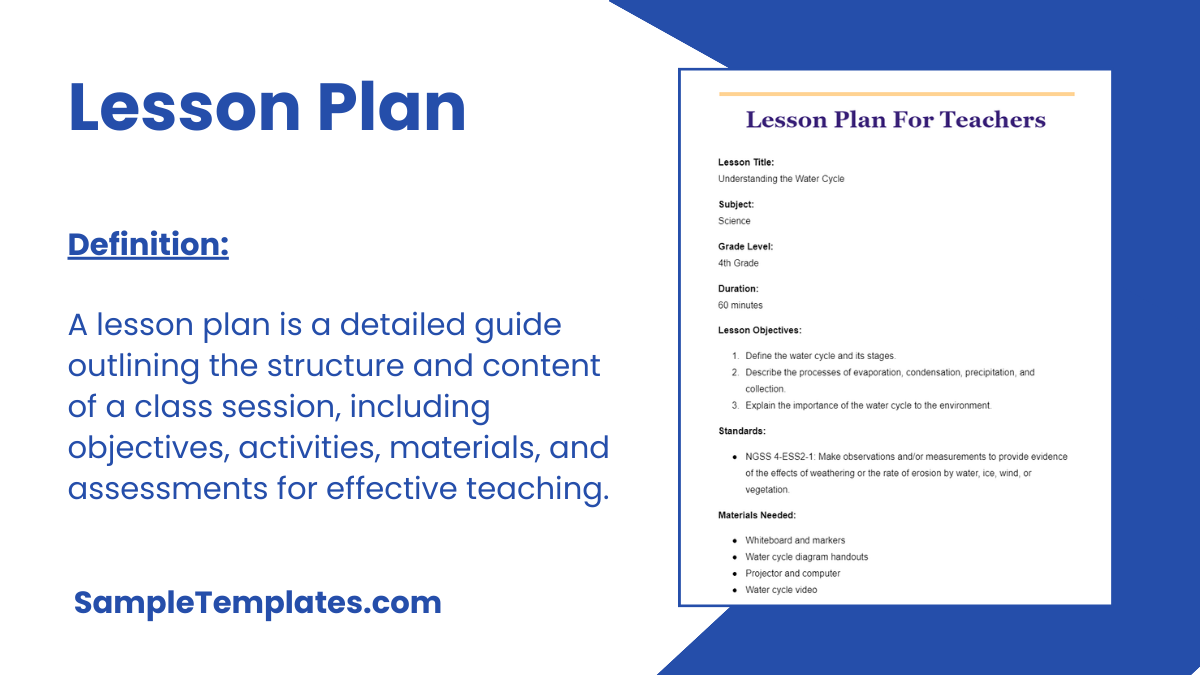For every school or university, a lesson plan is created by the teacher so they will have a guidelines and set of lessons that will be teach to the students for the rest of the school year. An organizing tool that contains all the topics of a subject every semester that students must comprehend in order to pass the examinations related to it.An example template is downloadable so you can have a sample format that can have the layout and strategies of teaching that can adjust for each level of education. Sample Preschool Lesson Plans is one of the important items aside from books that makes teacher be prepared and competitive when it comes in teaching students.
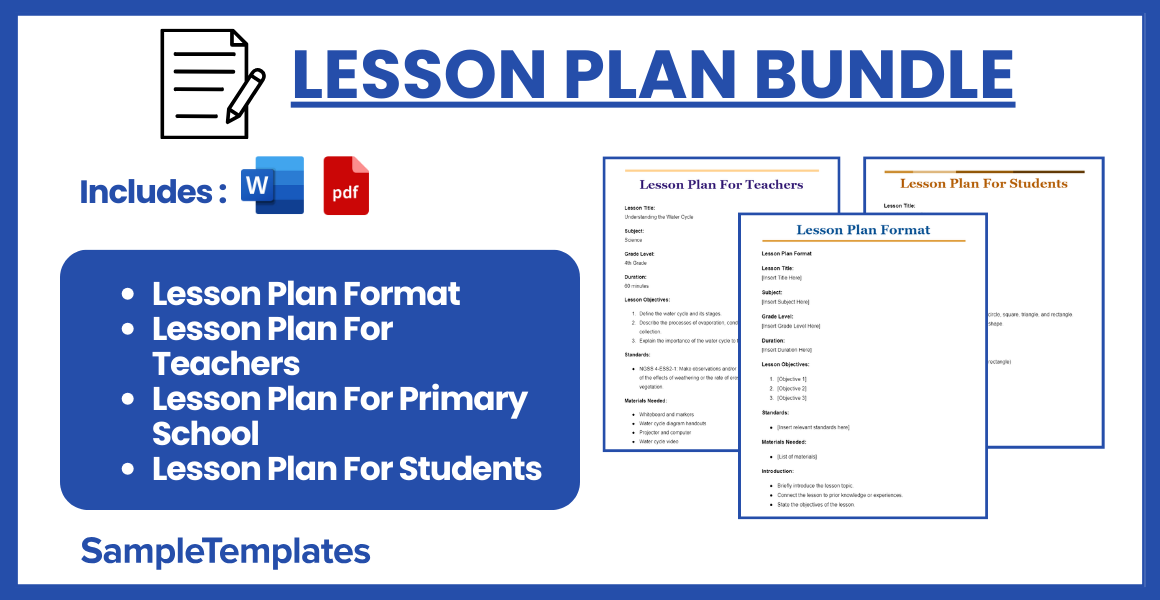
Lesson Plan Format
Lesson Plan Format
Lesson Title:
[Insert Title Here]
Subject:
[Insert Subject Here]
Grade Level:
[Insert Grade Level Here]
Duration:
[Insert Duration Here]
Lesson Objectives:
- [Objective 1]
- [Objective 2]
- [Objective 3]
Standards:
- [Insert relevant standards here]
Materials Needed:
- [List of materials]
Introduction:
- Briefly introduce the lesson topic.
- Connect the lesson to prior knowledge or experiences.
- State the objectives of the lesson.
Direct Instruction:
- Explain key concepts and ideas.
- Use visual aids, examples, and demonstrations.
- Engage students with questions and discussions.
Guided Practice:
- Provide activities where students can practice new skills with support.
- Monitor and provide feedback.
Independent Practice:
- Assign tasks that students can complete independently.
- Ensure these tasks reinforce the lesson objectives.
Assessment:
- Describe how you will assess student understanding (e.g., quizzes, observations, assignments).
- Include any rubrics or criteria for evaluation.
Closure:
- Summarize key points of the lesson.
- Connect the lesson to future learning.
- Provide opportunities for students to ask questions.
Differentiation:
- Detail strategies to accommodate diverse learners (e.g., advanced students, students with special needs).
- Include different methods of engagement, representation, and expression.
Reflection:
- Reflect on what went well and what could be improved.
- Consider student feedback and assessment results.

Lesson Plan For Teachers
Lesson Title:
Understanding the Water Cycle
Subject:
Science
Grade Level:
4th Grade
Duration:
60 minutes
Lesson Objectives:
- Define the water cycle and its stages.
- Describe the processes of evaporation, condensation, precipitation, and collection.
- Explain the importance of the water cycle to the environment.
Standards:
- NGSS 4-ESS2-1: Make observations and/or measurements to provide evidence of the effects of weathering or the rate of erosion by water, ice, wind, or vegetation.
Materials Needed:
- Whiteboard and markers
- Water cycle diagram handouts
- Projector and computer
- Water cycle video
- Glass jar, hot water, ice cubes, and a plate for demonstration
- Worksheets for assessment
Introduction: (10 minutes)
- Begin with a question: “Where do you think rain comes from?”
- Discuss students’ prior knowledge about water and weather.
- Introduce the lesson by explaining that they will learn about the journey of water through the water cycle.
Direct Instruction: (15 minutes)
- Use the whiteboard to draw and explain the stages of the water cycle: evaporation, condensation, precipitation, and collection.
- Show a water cycle diagram on the projector and explain each part in detail.
- Play a short educational video that illustrates the water cycle.
Guided Practice: (15 minutes)
- Conduct a hands-on demonstration of the water cycle:
- Fill a glass jar with hot water (to represent the earth).
- Place a plate on top of the jar with ice cubes on it (to represent the atmosphere).
- Observe how the water vapor condenses on the plate and drips down (like precipitation).
- Engage students with questions about what they observe and how it relates to the water cycle stages.
Independent Practice: (10 minutes)
- Distribute water cycle diagram handouts and have students label the stages.
- Provide a worksheet with questions about the water cycle for students to complete individually.
Assessment: (5 minutes)
- Collect and review the labeled diagrams and worksheets to assess understanding.
- Ask a few students to explain one stage of the water cycle in their own words.
Closure: (5 minutes)
- Summarize the key points of the lesson, highlighting the importance of the water cycle.
- Connect the lesson to real-life examples, such as rain, rivers, and lakes.
- Provide an opportunity for students to ask questions and share any final thoughts.
Differentiation:
- Provide visual aids and simplified diagrams for students who need additional support.
- Offer more challenging extension activities, such as researching the impact of the water cycle on different climates, for advanced learners.
- Pair students for the independent practice to encourage peer support.
Reflection:
- Reflect on student engagement and understanding during the lesson.
- Note any difficulties students had with particular concepts or activities.
- Consider adjustments for future lessons based on student feedback and assessment results.
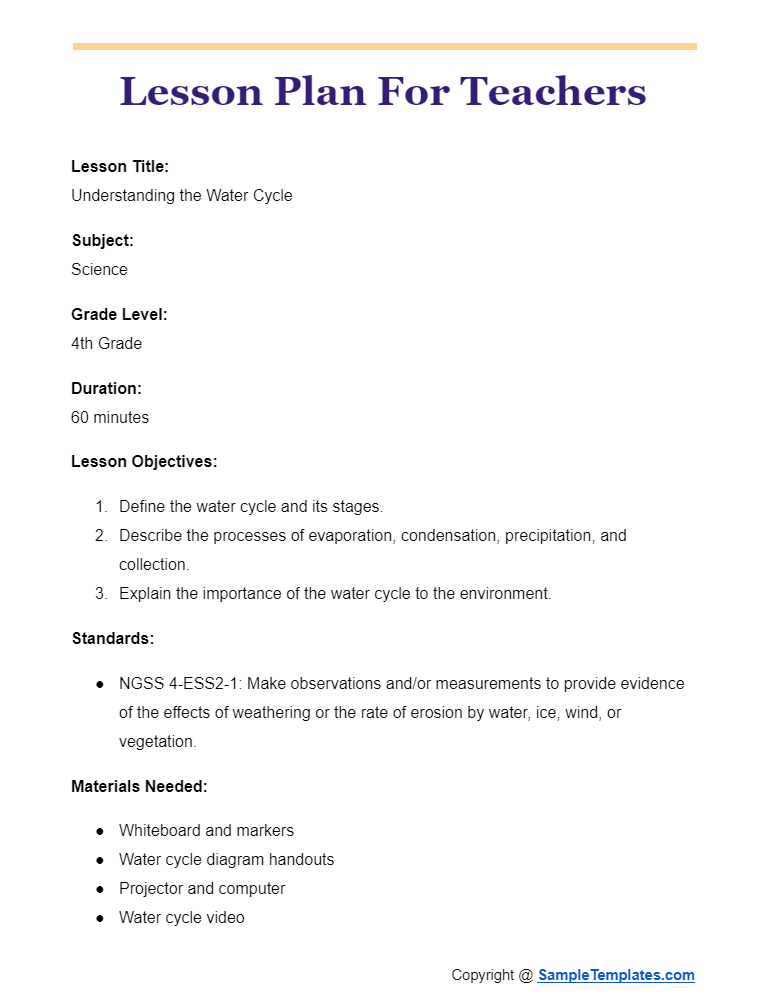
Lesson Plan For Primary School
Lesson Title:
Introduction to Shapes
Subject:
Mathematics
Grade Level:
1st Grade
Duration:
45 minutes
Lesson Objectives:
- Identify and name basic shapes: circle, square, triangle, rectangle.
- Describe the characteristics of each shape (number of sides, corners, etc.).
- Recognize shapes in the environment.
Standards:
- CCSS.MATH.CONTENT.K.G.A.2: Correctly name shapes regardless of their orientations or overall size.
Materials Needed:
- Shape cutouts (circle, square, triangle, rectangle)
- Interactive whiteboard or chart paper
- Markers
- Shape sorting worksheet
- Glue sticks
- Scissors
- Construction paper
- Picture book featuring shapes
Introduction: (10 minutes)
- Begin with a friendly greeting and a fun question: “Can anyone tell me what shapes they see in the classroom?”
- Read a picture book that features different shapes to capture students’ interest.
- Briefly introduce the lesson objectives, explaining that they will learn about shapes and how to find them around us.
Direct Instruction: (10 minutes)
- Use the interactive whiteboard or chart paper to draw each shape (circle, square, triangle, rectangle).
- Describe the characteristics of each shape:
- Circle: no sides, no corners.
- Square: 4 equal sides, 4 corners.
- Triangle: 3 sides, 3 corners.
- Rectangle: 4 sides (opposite sides are equal), 4 corners.
- Show real-life examples of each shape (e.g., clock for circle, book for rectangle).
Guided Practice: (10 minutes)
- Hand out shape cutouts to students.
- Call out a shape and ask students to hold up the correct cutout.
- Have students trace each shape with their finger in the air as you describe it again.
Independent Practice: (10 minutes)
- Provide a shape sorting worksheet where students cut out various shapes and glue them under the correct category (circle, square, triangle, rectangle).
- Walk around the classroom to assist students as needed.
Assessment: (5 minutes)
- Review the shape sorting worksheets to check for understanding.
- Ask a few students to name a shape and describe its characteristics.
Closure: (5 minutes)
- Summarize the key points of the lesson by revisiting the shapes on the whiteboard.
- Play a quick “I Spy” game where students find shapes around the classroom.
- Encourage students to look for shapes at home and share with the class the next day.
Differentiation:
- Provide additional support for students who need it by offering shape templates for tracing.
- Offer advanced students a challenge to find more complex shapes like ovals and hexagons.
- Use tactile materials like shape blocks for students who benefit from hands-on learning.
Reflection:
- Reflect on student engagement and understanding during the lesson.
- Note any difficulties students had with identifying or describing shapes.
- Consider adjustments for future lessons based on student feedback and assessment results.

Lesson Plan For Students
Lesson Title:
Learning About Shapes
Subject:
Math
Grade Level:
1st Grade
Duration:
45 minutes
Lesson Objectives:
- Learn the names of four basic shapes: circle, square, triangle, and rectangle.
- Understand the characteristics of each shape.
- Find and recognize shapes around us.
Materials Needed:
- Shape cutouts (circle, square, triangle, rectangle)
- Chart paper and markers
- Shape sorting worksheet
- Glue sticks
- Scissors
- Construction paper
- Picture book with shapes
Activities:
- Introduction (10 minutes):
- Story Time: Start with reading a fun picture book that talks about shapes.
- Discussion: Ask, “Can you name any shapes you see around us?”
- Learning Time (10 minutes):
- Shape Drawing: Draw each shape on chart paper and say its name out loud.
- Circle: “A circle is round with no corners.”
- Square: “A square has 4 equal sides and 4 corners.”
- Triangle: “A triangle has 3 sides and 3 corners.”
- Rectangle: “A rectangle has 4 sides, with opposite sides being equal.”
- Shape Drawing: Draw each shape on chart paper and say its name out loud.
- Activity Time (10 minutes):
- Shape Match: Give each student shape cutouts.
- Game: Call out a shape and let students hold up the matching cutout.
- Tracing Shapes: Let’s all trace shapes with our fingers in the air.
- Craft Time (10 minutes):
- Worksheet Fun: Give out worksheets with different shapes.
- Cut and Paste: Cut out shapes and glue them in the correct place on the worksheet.
- Review (5 minutes):
- Show and Tell: Ask a few students to name a shape and tell one thing about it.
- Quick Quiz: Hold up a shape and let students shout out its name.
- Wrap Up (5 minutes):
- Summary: Review all the shapes we learned today.
- Shape Hunt: Play “I Spy” and find shapes in the classroom.
- Home Challenge: Ask students to find shapes at home and share them next time.
Fun Extra Activities:
- Shape Art: Create a picture using different shapes.
- Shape Song: Sing a song about shapes.
Reflection:
- Think about what you enjoyed learning today.
- Share with a friend one new thing you learned about shapes.
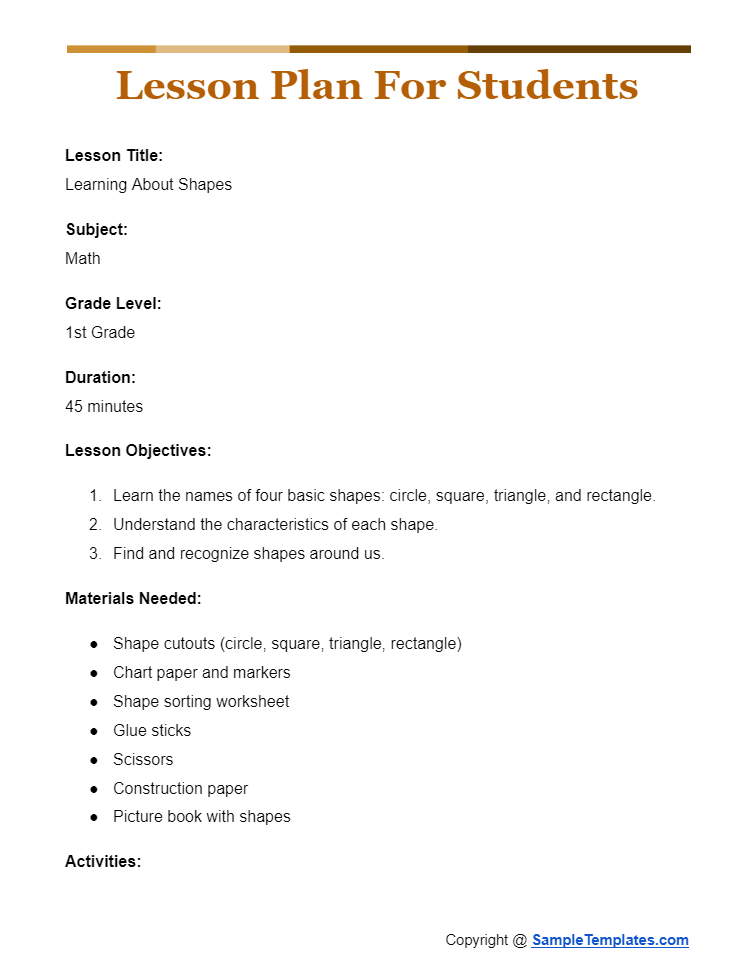
Browse More Templates On Letter of Interests
Multi-Class Lesson Plan Template
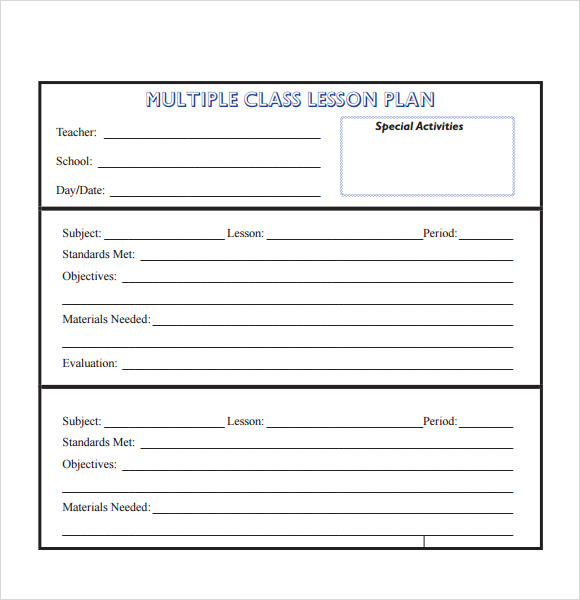
The multi-class lesson plan template helps in tracking the lesson right from preparation to the procedure of evaluation in a grid system that is quite easy to use.
Daily Lesson Plan Template with Subject Grid Pdf
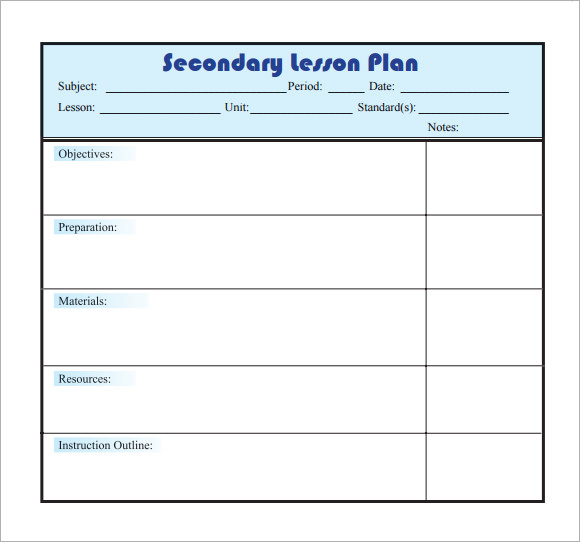
The daily lesson plan template in PDF format comes with easy to use subject grid and is one of the greatest ways for the secondary teachers to plan their daily lessons in details.
How to Create a Lesson Plan?
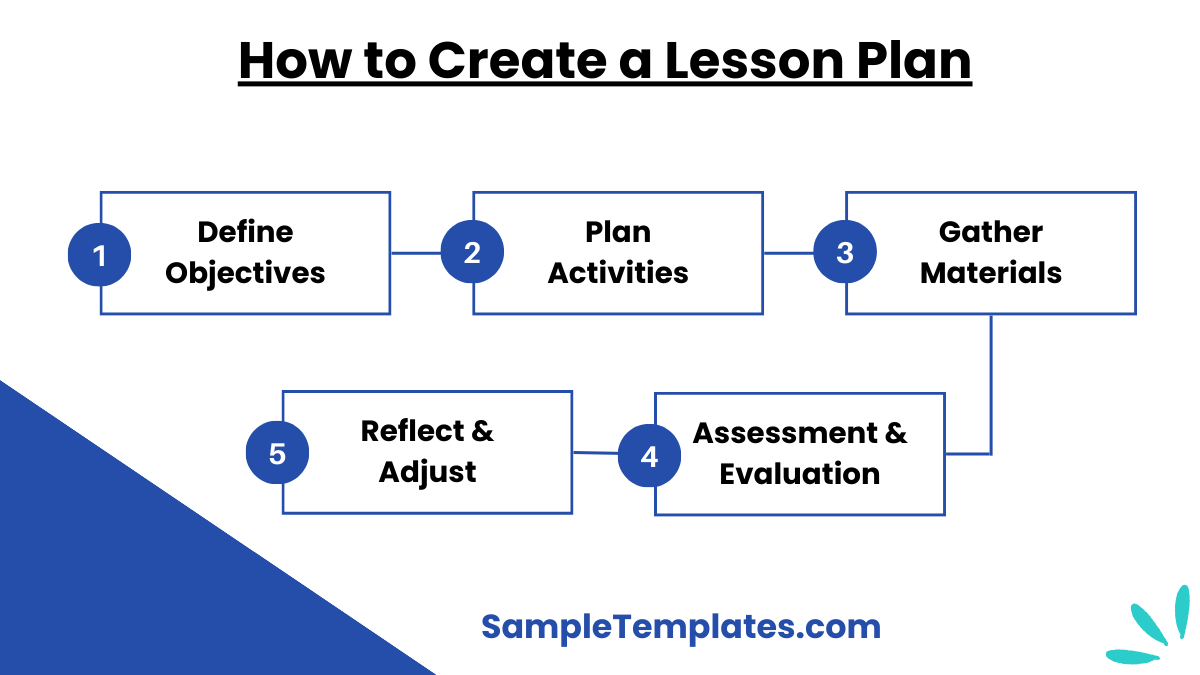
- Define Objectives:
- Clearly state what you want students to learn by the end of the lesson. These should be specific, measurable, attainable, relevant, and time-bound (SMART).
- Plan Activities:
- Outline the instructional activities you will use to achieve the lesson objectives. This includes direct instruction, guided practice, independent practice, and any interactive or hands-on activities.
- Gather Materials:
- List all the materials and resources you will need for the lesson, such as handouts, visual aids, technology, and supplies for activities. You can also see more on Yearly Lesson Plan.
- Assessment and Evaluation:
- Determine how you will assess students’ understanding and mastery of the lesson objectives. This can include quizzes, worksheets, oral questioning, or practical demonstrations.
- Reflect and Adjust:
- After delivering the lesson, reflect on what worked well and what could be improved. Use this reflection to adjust future lesson plans and better meet the needs of your students. You can also see more on Sample Lesson Plan Format.
Lesson Plan Template Doc
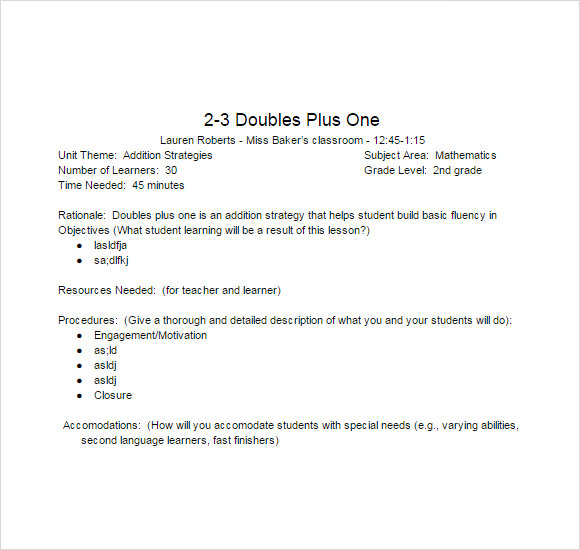
The lesson plan template in word document makes the procedure of teaching easy and simple for the teachers.
Detailed Unit Lesson Plan Template Pdf
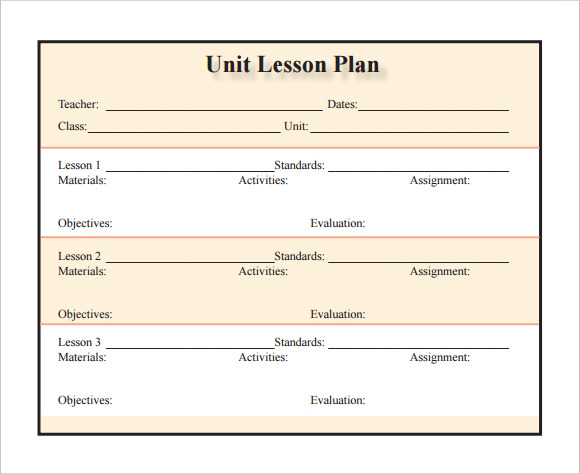
Components of a Lesson Plan
A comprehensive lesson plan typically includes several key components to ensure a structured and effective teaching session. Here are the essential components of a lesson plan:
- Lesson Title:
- The topic or main focus of the lesson.
- Grade Level:
- The appropriate grade level or age group for the lesson.
- Duration:
- The length of time allocated for the lesson.
- Lesson Objectives:
- Specific goals that students should achieve by the end of the lesson. These should be clear and measurable. You can also see more on Teacher Lesson Plan.
- Standards:
- Educational standards or benchmarks that the lesson aims to meet.
- Materials Needed:
- A list of all materials and resources required for the lesson, including handouts, books, visual aids, and technology.
- Introduction:
- A brief activity or discussion to introduce the lesson topic and engage students. This might include a hook, a question, or a connection to prior knowledge.
- Direct Instruction:
- The main teaching segment where the teacher presents new information or demonstrates skills. This could involve lectures, readings, demonstrations, or multimedia presentations.
- Guided Practice:
- Activities that allow students to practice new skills with teacher support. This can include group work, discussions, or hands-on activities with immediate feedback.
- Independent Practice:
- Activities that students complete on their own to reinforce learning. This could be homework, individual assignments, or in-class tasks.
- Assessment:
- Methods for evaluating student understanding and mastery of lesson objectives. This can include quizzes, tests, observations, or performance tasks.
- Closure:
- A concluding activity to wrap up the lesson. This might involve summarizing key points, reviewing objectives, or discussing the lesson’s relevance to future learning.
- Differentiation:
- Strategies to address the diverse needs of learners, including accommodations for students with special needs and extensions for advanced learners. You can also see more on Daily Lesson Plan.
- Reflection:
- A section for the teacher to reflect on the lesson’s effectiveness and note any adjustments for future lessons. This can include observations about student engagement and understanding.
Master Lesson Plan Doc
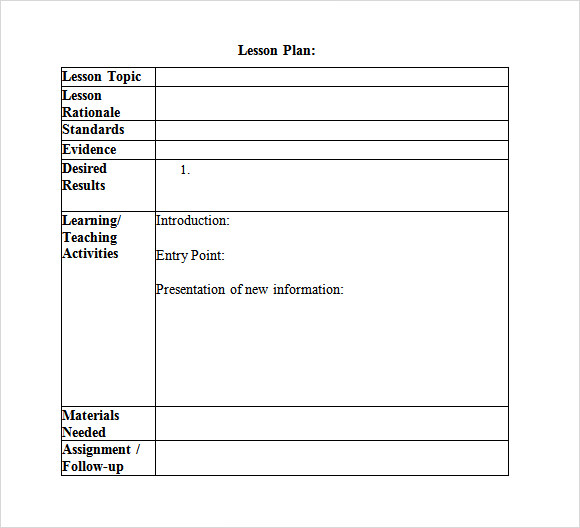
Types of Lesson Plan
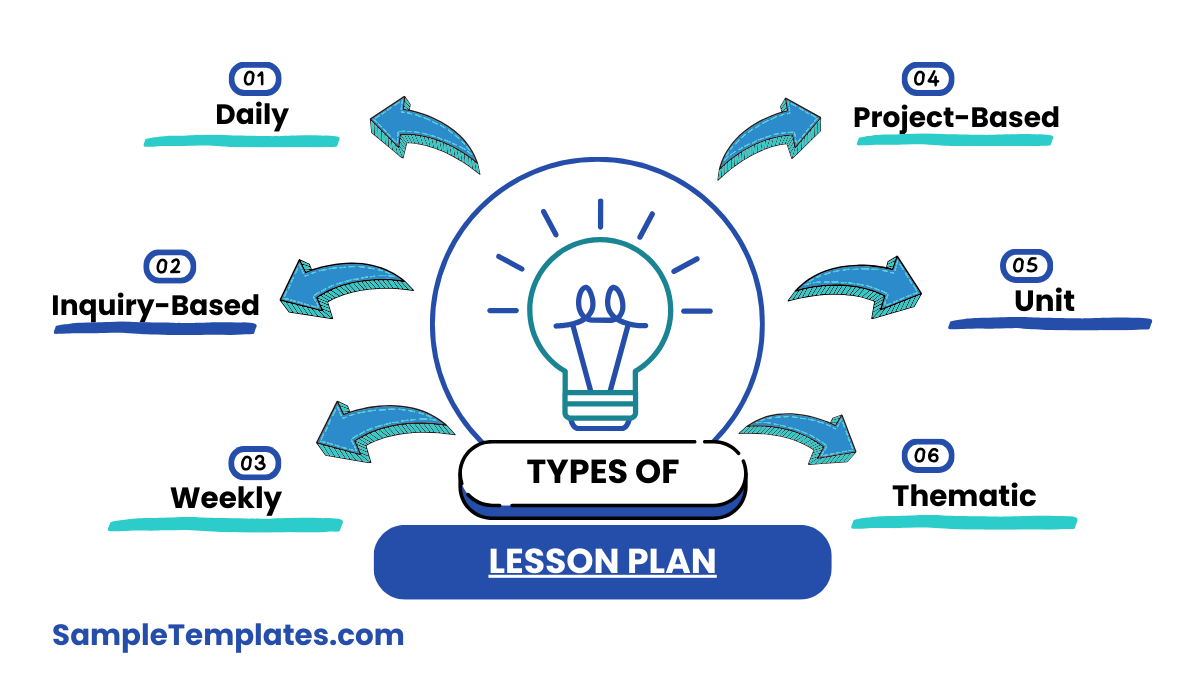
- Daily Lesson Plan:
- A detailed plan for a single day’s lesson, outlining specific activities and objectives for that day.
- Weekly Lesson Plan:
- A plan that outlines the lessons and activities for an entire week, providing a broader view of the curriculum.
- Unit Lesson Plan:
- A sample plan that covers a complete unit of study, usually over several weeks, detailing all lessons, activities, and assessments within that unit.
- Inquiry-Based Lesson Plan:
- A plan that focuses on student inquiry and exploration, encouraging students to ask questions and investigate topics deeply.
- Project-Based Lesson Plan:
- A plan centered around a project that students work on over a period of time, integrating multiple subjects and skills.
- Differentiated Lesson Plan:
- A plan designed to address the diverse needs of students by providing different pathways to learning, including varied activities, materials, and assessments.
- Thematic Lesson Plan:
- A plan that integrates various subjects around a central theme, making connections across disciplines.
- Flipped Classroom Lesson Plan:
- A plan where students first learn new content at home (e.g., through videos or readings) and then engage in hands-on activities and discussions in class to reinforce and apply that knowledge. You can also see more on Blank Lesson Plan.
Patrick Alles Lesson Plan Template Excel

Simple Lesson Plan Word
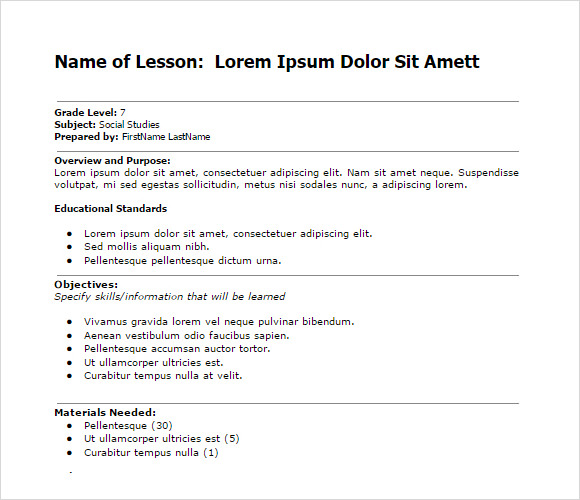
Benefits of Lesson Plan
- Organized Instruction:
- Provides a clear roadmap for the teacher, ensuring that the lesson is structured and flows logically.
- Focused Objectives:
- Helps teachers define specific learning goals, ensuring that all activities and assessments are aligned with these objectives.
- Efficient Use of Time:
- Ensures that instructional time is used effectively, covering all necessary content within the allotted time frame. You can also see more on Simple Lesson Plan.
- Enhanced Student Engagement:
- Incorporates varied activities and teaching methods, keeping students interested and engaged throughout the lesson.
- Improved Classroom Management:
- Reduces classroom disruptions by providing a clear plan and keeping students on task.
- Adaptability:
- Allows for adjustments based on student needs and responses, providing flexibility to address different learning paces and styles.
- Assessment and Evaluation:
- Includes built-in assessment strategies, helping teachers gauge student understanding and adjust instruction as needed.
- Professional Growth:
- Encourages reflection and continuous improvement, helping teachers evaluate the effectiveness of their lessons and make necessary adjustments for future instruction.
Lesson plan templates are available in different formats and they can easily be downloaded online. They come as the best help for teachers and instructors. You can also see Sample Daily Lesson Plans.
Weekly Lesson Plan Template with Standards Pdf
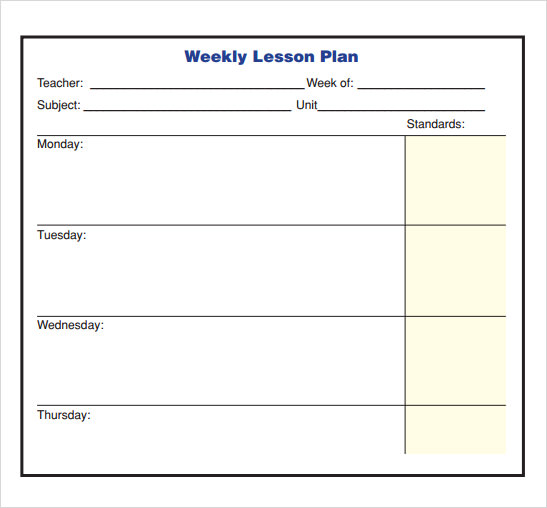
Weekly Multi Period Lesson Plan Template Pdf
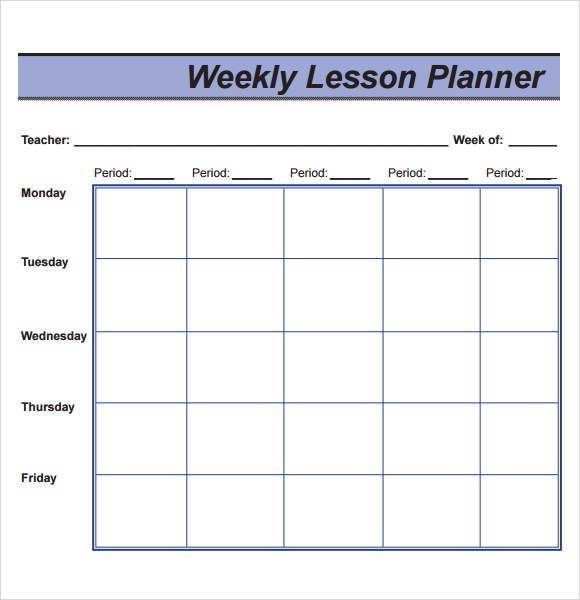
Why Do You Need Lesson Plan Templates?
If you are a teacher in a college or a school, you will definitely need a lesson plan template. There are different varieties of lesson plan templates available in simple designs with customizable size and font to be used for the daily planning of lessons. These templates can also be used for monthly planning the lessons subject wise. Teachers can gain high rates of success in their teaching by making use of lesson plan templates. These templates enable the teachers to offer their students the best knowledge of a subject. The lesson plan templates available online come in pre-designed formats and can be filled out using standard color and font. The only thing that needs to be done is taking out a print of the template and using it for initiating a class. There are daily planning, monthly planning, weekly planning and subject wise planning templates available. You can also see Art Lesson Plans.
Tips to Create Lesson Plan Templates
Lesson plan templates are generally generic and they are not aimed towards a particular type of trainer, instructor, activity or teacher. All the important information that needs to be entered in the lesson plans can specifically be entered in the blank fields that are provided in the lesson plan templates. The use of these templates helps in delivering proper learning. A good lesson plan template should have separate fields for filling out details like lesson objectives, activities and tasks, equipment or materials used during the class, references and take home activities or tasks. All these points need to be essentially present in a lesson plan template. The inclusion of all these points actually helps in making the template effective and useful for a teacher or an instructor. You can also see more on Lesson Plan Objective.
What are the 4 C’s lesson plan?
The 4 C’s are Critical thinking, Communication, Collaboration, and Creativity, focusing on developing essential skills for students to thrive in a modern, interconnected world through engaging and interactive learning activities. You can also see more on Printable Lesson Plan.
What are the 4 A’s of a lesson plan?
The 4 A’s are Activity, Analysis, Abstraction, and Application, emphasizing structured learning phases where students engage in activities, analyze information, abstract concepts, and apply knowledge to real-world situations.
What is a 5 minute lesson plan?
A 5-minute lesson plan is a concise, streamlined planning method focusing on key elements: lesson objectives, activities, assessment, and differentiation, enabling quick preparation while ensuring clarity and effectiveness in delivering instruction. You can also see more on University Lesson Plan.
What makes a good lesson plan?
A good lesson plan is clear, structured, and engaging, with well-defined objectives, varied activities, and assessments. It addresses diverse learning needs, promotes active participation, and includes opportunities for reflection and feedback.
A well-crafted lesson plan outline concludes by reflecting on the learning outcomes, assessing effectiveness, and suggesting future improvements to enhance educational experiences and student engagement.
If you have any DMCA issues on this post, please contact us!
Related Posts
Weekly Schedule Samples & Templates
Contractual Agreement Samples & Templates
FREE 9+ Amazing Sample Church Bulletin Templates in PSD | PDF
Sample Business Card Templates
Sample Cashier Job Descriptions
Questionnaire Samples
FREE 10+ Sample HR Resource Templates in PDF
FREE 49+ Sample Job Descriptions in PDF | MS Word
FREE 16+ Nonprofit Budget Samples in PDF | MS Word | Excel | Google Docs | Google Sheets | Numbers | Pages
FREE 13+ Academic Calendar Templates in Google Docs | MS Word | Pages | PDF
FREE 10+ How to Create an Executive Summary Samples in Google Docs | MS Word | Pages | PDF
FREE 23+ Sample Event Calendar Templates in PDF | MS Word | Google Docs | Apple Pages
Company Profile Samples
FREE 10+ Leadership Report Samples [ Development, Training, Camp ]
FREE 24+ Sample Payment Schedules in PDF | MS Word
